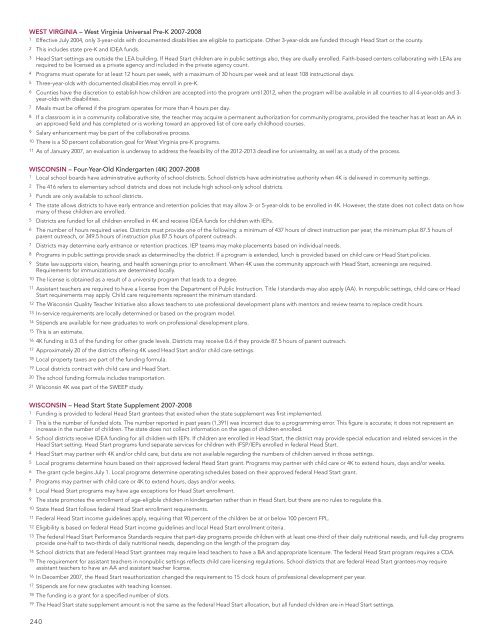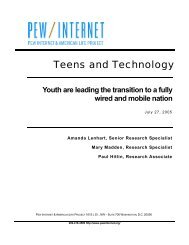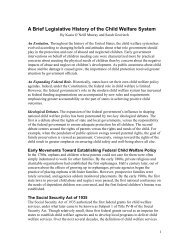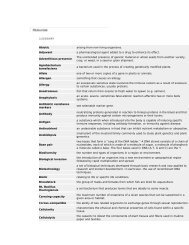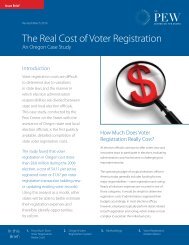WEST VIRGINIA – West Virginia Universal Pre-K 2007-<strong>2008</strong> 1 Effective July 2004, only 3-year-olds with documented disabilities are eligible to participate. Other 3-year-olds are funded through Head Start or the county. 2 This includes state pre-K and IDEA funds. 3 Head Start settings are outside the LEA building. If Head Start children are in public settings also, they are dually enrolled. Faith-based centers collaborating with LEAs are required to be licensed as a private agency and included in the private agency count. 4 Programs must operate for at least 12 hours per week, with a maximum <strong>of</strong> 30 hours per week and at least 108 instructional days. 5 Three-year-olds with documented disabilities may enroll in pre-K. 6 Counties have the discretion to establish how children are accepted into the program until 2012, when the program will be available in all counties to all 4-year-olds and 3- year-olds with disabilities. 7 Meals must be <strong>of</strong>fered if the program operates for more than 4 hours per day. 8 If a classroom is in a community collaborative site, the teacher may acquire a permanent authorization for community programs, provided the teacher has at least an AA in an approved field and has completed or is working toward an approved list <strong>of</strong> core early childhood courses. 9 Salary enhancement may be part <strong>of</strong> the collaborative process. 10 <strong>The</strong>re is a 50 percent collaboration goal for West Virginia pre-K programs. 11 As <strong>of</strong> January 2007, an evaluation is underway to address the feasibility <strong>of</strong> the 2012-2013 deadline for universality, as well as a study <strong>of</strong> the process. WISCONSIN – Four-Year-Old Kindergarten (4K) 2007-<strong>2008</strong> 1 Local school boards have administrative authority <strong>of</strong> school districts. School districts have administrative authority when 4K is delivered in community settings. 2 <strong>The</strong> 416 refers to elementary school districts and does not include high school-only school districts. 3 Funds are only available to school districts. 4 <strong>The</strong> state allows districts to have early entrance and retention policies that may allow 3- or 5-year-olds to be enrolled in 4K. However, the state does not collect data on how many <strong>of</strong> these children are enrolled. 5 Districts are funded for all children enrolled in 4K and receive IDEA funds for children with IEPs. 6 <strong>The</strong> number <strong>of</strong> hours required varies. Districts must provide one <strong>of</strong> the following: a minimum <strong>of</strong> 437 hours <strong>of</strong> direct instruction per year, the minimum plus 87.5 hours <strong>of</strong> parent outreach, or 349.5 hours <strong>of</strong> instruction plus 87.5 hours <strong>of</strong> parent outreach. 7 Districts may determine early entrance or retention practices. IEP teams may make placements based on individual needs. 8 Programs in public settings provide snack as determined by the district. If a program is extended, lunch is provided based on child care or Head Start policies. 9 <strong>State</strong> law supports vision, hearing, and health screenings prior to enrollment. When 4K uses the community approach with Head Start, screenings are required. Requirements for immunizations are determined locally. 10 <strong>The</strong> license is obtained as a result <strong>of</strong> a university program that leads to a degree. 11 Assistant teachers are required to have a license from the Department <strong>of</strong> Public Instruction. Title I standards may also apply (AA). In nonpublic settings, child care or Head Start requirements may apply. Child care requirements represent the minimum standard. 12 <strong>The</strong> Wisconsin Quality Teacher Initiative also allows teachers to use pr<strong>of</strong>essional development plans with mentors and review teams to replace credit hours. 13 In-service requirements are locally determined or based on the program model. 14 Stipends are available for new graduates to work on pr<strong>of</strong>essional development plans. 15 This is an estimate. 16 4K funding is 0.5 <strong>of</strong> the funding for other grade levels. Districts may receive 0.6 if they provide 87.5 hours <strong>of</strong> parent outreach. 17 Approximately 20 <strong>of</strong> the districts <strong>of</strong>fering 4K used Head Start and/or child care settings. 18 Local property taxes are part <strong>of</strong> the funding formula. 19 Local districts contract with child care and Head Start. 20 <strong>The</strong> school funding formula includes transportation. 21 Wisconsin 4K was part <strong>of</strong> the SWEEP study. WISCONSIN – Head Start <strong>State</strong> Supplement 2007-<strong>2008</strong> 1 Funding is provided to federal Head Start grantees that existed when the state supplement was first implemented. 2 This is the number <strong>of</strong> funded slots. <strong>The</strong> number reported in past years (1,391) was incorrect due to a programming error. This figure is accurate; it does not represent an increase in the number <strong>of</strong> children. <strong>The</strong> state does not collect information on the ages <strong>of</strong> children enrolled. 3 School districts receive IDEA funding for all children with IEPs. If children are enrolled in Head Start, the district may provide special education and related services in the Head Start setting. Head Start programs fund separate services for children with IFSP/IEPs enrolled in federal Head Start. 4 Head Start may partner with 4K and/or child care, but data are not available regarding the numbers <strong>of</strong> children served in those settings. 5 Local programs determine hours based on their approved federal Head Start grant. Programs may partner with child care or 4K to extend hours, days and/or weeks. 6 <strong>The</strong> grant cycle begins July 1. Local programs determine operating schedules based on their approved federal Head Start grant. 7 Programs may partner with child care or 4K to extend hours, days and/or weeks. 8 Local Head Start programs may have age exceptions for Head Start enrollment. 9 <strong>The</strong> state promotes the enrollment <strong>of</strong> age-eligible children in kindergarten rather than in Head Start, but there are no rules to regulate this. 10 <strong>State</strong> Head Start follows federal Head Start enrollment requirements. 11 Federal Head Start income guidelines apply, requiring that 90 percent <strong>of</strong> the children be at or below 100 percent FPL. 12 Eligibility is based on federal Head Start income guidelines and local Head Start enrollment criteria. 13 <strong>The</strong> federal Head Start Performance Standards require that part-day programs provide children with at least one-third <strong>of</strong> their daily nutritional needs, and full-day programs provide one-half to two-thirds <strong>of</strong> daily nutritional needs, depending on the length <strong>of</strong> the program day. 14 School districts that are federal Head Start grantees may require lead teachers to have a BA and appropriate licensure. <strong>The</strong> federal Head Start program requires a CDA. 15 <strong>The</strong> requirement for assistant teachers in nonpublic settings reflects child care licensing regulations. School districts that are federal Head Start grantees may require assistant teachers to have an AA and assistant teacher license. 16 In December 2007, the Head Start reauthorization changed the requirement to 15 clock hours <strong>of</strong> pr<strong>of</strong>essional development per year. 17 Stipends are for new graduates with teaching licenses. 18 <strong>The</strong> funding is a grant for a specified number <strong>of</strong> slots. 19 <strong>The</strong> Head Start state supplement amount is not the same as the federal Head Start allocation, but all funded children are in Head Start settings. 240
APPENDIX B: HEAD START DATA STATE STATE-FUNDED HEAD START FEDERAL HEAD START <strong>State</strong> funding (Fiscal Year <strong>2008</strong>) <strong>State</strong> enrollment: additional funded slots for 3- and 4- year-olds (<strong>2008</strong>) 1 Federal actual spending (Fiscal Year <strong>2008</strong>) 2 3 2007-<strong>2008</strong>) 5 Funded enrollment by state (Program Year 2007-<strong>2008</strong>) American Indian/ Alaskan Native enrollment (Program Year 2007-<strong>2008</strong>) Migrant enrollment (Program Year 3-year-olds 4-year-olds 3-year-olds 4-year-olds 3-year-olds 4-year-olds Alabama $107,287,264 6,096 9,268 0 0 13 23 Alaska $6,077,200 374 6 $24,218,993 518 856 488 478 0 0 Arizona $105,349,599 3,538 8,021 1,867 3,148 246 299 Arkansas $120,778,974 4,469 5,193 0 0 102 74 California $860,660,232 32,509 55,685 229 316 1,470 1,261 Colorado $72,847,945 3,246 5,163 63 76 123 115 Connecticut $5,500,000 489 7 $52,035,272 2,703 3,490 0 0 0 0 Delaware $5,727,800 843 $13,460,747 693 927 0 0 11 8 District <strong>of</strong> Columbia $25,173,901 1,573 1,446 0 0 0 0 Florida $278,498,426 12,223 19,500 0 0 893 854 Georgia $170,064,051 12,315 9,478 0 0 82 47 Hawaii $22,946,443 1,038 1,629 0 0 0 0 Idaho $1,500,000 191 $26,677,079 658 1,973 90 107 164 186 Illinois $274,933,443 14,977 19,051 0 0 74 76 Indiana $96,453,542 4,565 7,305 0 0 0 0 Iowa $51,685,391 2,502 3,481 0 0 0 0 Kansas $51,627,873 2,992 3,451 34 25 0 0 Kentucky $108,565,188 5,856 8,868 0 0 26 24 Louisiana $146,556,188 10,788 9,389 0 0 14 11 Maine $3,937,668 355 8 $28,232,203 1,311 1,840 27 33 0 0 Maryland $3,000,000 1,508 9 $78,239,829 4,456 4,744 0 0 0 0 Massachusetts $9,000,000 203 10 $108,912,617 4,895 6,214 0 0 29 5 Michigan $243,268,858 12,434 19,632 144 148 262 208 Minnesota $19,520,751 1,866 11 $77,200,270 3,630 5,354 76 103 169 143 Mississippi $164,017,701 10,274 14,870 145 63 0 0 Missouri $119,305,226 6,364 8,382 0 0 0 0 Montana $34,647,161 1,018 1,604 580 716 0 0 Nebraska $38,481,003 1,654 2,421 98 127 13 14 Nevada $27,653,963 996 1,453 120 200 0 0 New Hampshire $331,337 12 0 $13,421,239 570 805 0 0 0 0 New Jersey $129,939,640 5,185 6,985 0 0 44 15 New Mexico $1,496,915 13 0 $65,577,341 1,880 3,702 478 698 0 0 New York $437,261,750 18,676 24,316 76 67 91 91 North Carolina $152,572,956 6,262 10,796 96 80 184 146 North Dakota $18,829,400 777 1,277 369 447 0 0 Ohio $247,546,666 14,395 18,256 0 0 0 0 Oklahoma $2,905,602 14 0 $104,379,214 5,749 6,763 1,232 1,277 0 0 Oregon $42,500,000 4,884 $73,640,700 3,334 5,692 107 197 562 498 Pennsylvania $40,000,000 5,780 $230,429,859 12,731 18,638 0 0 98 69 Rhode Island $2,970,000 400 $22,073,130 916 1,470 0 0 0 0 South Carolina $83,583,138 5,786 5,811 0 0 41 42 South Dakota $32,426,317 958 1,356 469 813 0 0 Tennessee $120,514,189 5,842 9,538 0 0 46 43 Texas $513,147,819 27,916 33,793 17 17 2,211 1,664 Utah $41,579,638 1,509 3,568 96 119 80 89 Vermont $13,595,041 569 636 0 0 0 0 Virginia $100,309,314 5,124 7,096 0 0 61 40 Washington $119,279,032 3,358 5,989 494 554 598 509 West Virginia $50,776,400 2,565 4,464 0 0 0 0 Wisconsin $7,212,500 1,229 $99,846,240 6,076 5,948 372 340 85 92 Wyoming $14,223,550 569 859 89 94 0 0 50 <strong>State</strong>s + DC 15 $151,679,773 18,122 $6,214,731,954 301,038 418,449 7,857 10,242 7,792 6,645 Data sources a a b b b b b b b 241
- Page 1 and 2:
NATIONAL INSTITUTE FOR EARLY EDUCAT
- Page 3 and 4:
THE STATE OF PRESCHOOL 2008 STATE P
- Page 5 and 6:
Nebraska ..........................
- Page 7 and 8:
NATIONAL ACCESS Total state program
- Page 9 and 10:
STATE-FUNDED PRESCHOOL EDUCATION: P
- Page 11 and 12:
SHADOWS OF THINGS THAT MAY BE As st
- Page 13 and 14:
QUALITY STANDARDS: MEETING GREAT EX
- Page 15 and 16:
RESOURCES: HARD TIMES AHEAD? During
- Page 17 and 18:
TABLE 2: PRE-K ACCESS BY STATE ACCE
- Page 19 and 20:
TABLE 4: 2007-2008 ENROLLMENT OF 3-
- Page 21 and 22:
TABLE 6: RANKINGS OF PRE-K RESOURCE
- Page 23 and 24:
WHAT QUALIFIES AS A STATE PRESCHOOL
- Page 25 and 26:
The sections below provide an overv
- Page 27 and 28:
Early learning standards are also c
- Page 29 and 30:
ACCESS Total state program enrollme
- Page 32 and 33:
PERCENT OF STATE POPULATION ENROLLE
- Page 34 and 35:
NO PROGRAM laska has provided a sup
- Page 36 and 37:
PERCENT OF STATE POPULATION ENROLLE
- Page 38 and 39:
PERCENT OF STATE POPULATION ENROLLE
- Page 40 and 41:
PERCENT OF STATE POPULATION ENROLLE
- Page 42 and 43:
PERCENT OF STATE POPULATION ENROLLE
- Page 44 and 45:
PERCENT OF STATE POPULATION ENROLLE
- Page 46 and 47:
PERCENT OF STATE POPULATION ENROLLE
- Page 48 and 49:
PERCENT OF STATE POPULATION ENROLLE
- Page 50 and 51:
PERCENT OF STATE POPULATION ENROLLE
- Page 52 and 53:
NO PROGRAM awaii does not have a st
- Page 54 and 55:
NO PROGRAM ACCESS RANKINGS 4-YEAR-O
- Page 56 and 57:
PERCENT OF STATE POPULATION ENROLLE
- Page 58 and 59:
NO PROGRAM ACCESS RANKINGS 4-YEAR-O
- Page 60 and 61:
PERCENT OF STATE POPULATION ENROLLE
- Page 62 and 63:
IOWA SHARED VISIONS ACCESS Total st
- Page 64 and 65:
PERCENT OF STATE POPULATION ENROLLE
- Page 66 and 67:
PERCENT OF STATE POPULATION ENROLLE
- Page 68 and 69:
PERCENT OF STATE POPULATION ENROLLE
- Page 70 and 71:
LOUISIANA 8(g) STUDENT ENHANCEMENT
- Page 72:
LOUISIANA NONPUBLIC SCHOOLS EARLY C
- Page 75 and 76:
MAINE PUBLIC PRESCHOOL PROGRAM ACCE
- Page 77 and 78:
MARYLAND PREKINDERGARTEN PROGRAM AC
- Page 79 and 80:
MASSACHUSETTS UNIVERSAL PRE-KINDERG
- Page 81 and 82:
MICHIGAN SCHOOL READINESS PROGRAM A
- Page 83 and 84:
MINNESOTA HEAD START ACCESS Total s
- Page 85 and 86:
ACCESS Total state program enrollme
- Page 87 and 88:
MISSOURI PRESCHOOL PROJECT ACCESS T
- Page 89 and 90:
ACCESS Total state program enrollme
- Page 91 and 92:
NEBRASKA EARLY CHILDHOOD EDUCATION
- Page 93 and 94:
NEVADA STATE PREKINDERGARTEN EDUCAT
- Page 95 and 96:
ACCESS Total state program enrollme
- Page 97 and 98:
STATE OVERVIEW Total state program
- Page 99 and 100:
NEW JERSEY NON-ABBOTT EARLY CHILDHO
- Page 102 and 103:
PERCENT OF STATE POPULATION ENROLLE
- Page 104 and 105:
PERCENT OF STATE POPULATION ENROLLE
- Page 106 and 107:
PERCENT OF STATE POPULATION ENROLLE
- Page 108 and 109:
NO PROGRAM ACCESS RANKINGS 4-YEAR-O
- Page 110 and 111:
PERCENT OF STATE POPULATION ENROLLE
- Page 112 and 113:
OHIO EARLY CHILDHOOD EDUCATION ACCE
- Page 114 and 115:
PERCENT OF STATE POPULATION ENROLLE
- Page 116 and 117:
PERCENT OF STATE POPULATION ENROLLE
- Page 118 and 119:
PERCENT OF STATE POPULATION ENROLLE
- Page 120 and 121:
PENNSYLVANIA EDUCATION ACCOUNTABILI
- Page 122 and 123:
PENNSYLVANIA HEAD START SUPPLEMENTA
- Page 124 and 125:
NO PROGRAM uring the 2007-2008 scho
- Page 126 and 127:
PERCENT OF STATE POPULATION ENROLLE
- Page 128 and 129:
SOUTH CAROLINA HALF-DAY CHILD DEVEL
- Page 130 and 131:
NO PROGRAM ACCESS RANKINGS 4-YEAR-O
- Page 132 and 133:
PERCENT OF STATE POPULATION ENROLLE
- Page 134 and 135:
PERCENT OF STATE POPULATION ENROLLE
- Page 136 and 137:
NO PROGRAM ACCESS RANKINGS 4-YEAR-O
- Page 138 and 139:
PERCENT OF STATE POPULATION ENROLLE
- Page 140 and 141:
VERMONT PREKINDERGARTEN EDUCATION -
- Page 142 and 143:
PERCENT OF STATE POPULATION ENROLLE
- Page 144 and 145:
PERCENT OF STATE POPULATION ENROLLE
- Page 146 and 147:
PERCENT OF STATE POPULATION ENROLLE
- Page 148 and 149:
PERCENT OF STATE POPULATION ENROLLE
- Page 150 and 151:
WISCONSIN FOUR-YEAR-OLD KINDERGARTE
- Page 152 and 153:
NO PROGRAM ACCESS RANKINGS 4-YEAR-O
- Page 154 and 155:
METHODOLOGY The data in this report
- Page 156 and 157:
In the 2008 Yearbook, we attempt to
- Page 158 and 159:
APPENDIX A: STATE SURVEY DATA 2007-
- Page 160 and 161:
STATE ACCESS Number of children in
- Page 162 and 163:
STATE ACCESS Are children receiving
- Page 164 and 165:
STATE ACCESS Program enrollment - F
- Page 166 and 167:
STATE OPERATING SCHEDULE Minimum op
- Page 168 and 169:
STATE AGE ELIGIBILITY Minimum age f
- Page 170 and 171:
STATE AGE ELIGIBILITY State policy
- Page 172 and 173:
STATE INCOME REQUIREMENT Income req
- Page 174 and 175:
STATE OTHER ELIGIBILITY REQUIREMENT
- Page 176 and 177:
STATE OTHER ELIGIBILITY REQUIREMENT
- Page 178 and 179:
STATE PROGRAM STANDARDS Maximum cla
- Page 180 and 181:
STATE PROGRAM STANDARDS Support ser
- Page 182 and 183:
STATE PROGRAM STANDARDS Support ser
- Page 184 and 185:
STATE PROGRAM STANDARDS Alabama 2 N
- Page 186 and 187:
STATE STATEWIDE EARLY LEARNING STAN
- Page 188 and 189:
STATE STATEWIDE EARLY LEARNING STAN
- Page 190 and 191:
STATE STATEWIDE EARLY LEARNING STAN
- Page 192 and 193: STATE PERSONNEL Minimum teacher deg
- Page 194 and 195: STATE PERSONNEL Education level of
- Page 196 and 197: STATE PERSONNEL Assistant teacher i
- Page 198 and 199: STATE PERSONNEL State supports for
- Page 200 and 201: STATE RESOURCES State funding sourc
- Page 202 and 203: STATE RESOURCES Required local fund
- Page 204 and 205: STATE RESOURCES Agencies eligible t
- Page 206 and 207: STATE RESOURCES Is there a percenta
- Page 208 and 209: STATE RESOURCES Are per-child/per-c
- Page 210 and 211: STATE RESOURCES Can a child be fund
- Page 212 and 213: STATE MONITORING Information collec
- Page 214 and 215: STATE MONITORING How is monitoring
- Page 216 and 217: STATE MONITORING What program recor
- Page 218 and 219: STATE MONITORING How is information
- Page 220 and 221: STATE Alabama Yes Specific assessme
- Page 222 and 223: STATE MONITORING Required kindergar
- Page 224 and 225: 14 Children are assessed at three d
- Page 226 and 227: DELAWARE - Early Childhood Assistan
- Page 228 and 229: 3 Kansas began a pre-K pilot that s
- Page 230 and 231: 7 While not required, most programs
- Page 232 and 233: 19 The formula uses free lunch and
- Page 234 and 235: 18 Evaluation of program-level outc
- Page 236 and 237: 13 The state allocates the same amo
- Page 238 and 239: 11 Beginning in 2009-2010, assistan
- Page 240 and 241: 20 The Office of Early Learning (OE
- Page 244 and 245: APPENDIX B: HEAD START DATA (contin
- Page 246 and 247: APPENDIX C: CHILD CARE DATA STATE I
- Page 248 and 249: APPENDIX C: CHILD CARE DATA (contin
- Page 250 and 251: APPENDIX C: CHILD CARE DATA (contin
- Page 252 and 253: APPENDIX E: PRE-K SPECIAL EDUCATION
- Page 254: ISBN 0-9749910-5-8 $59.95


